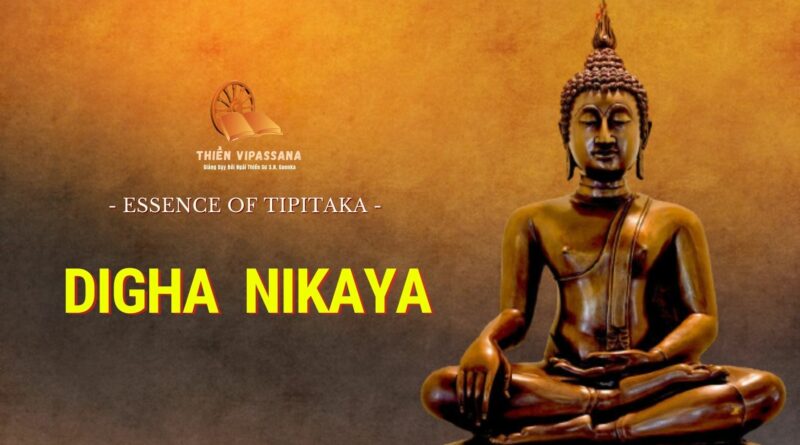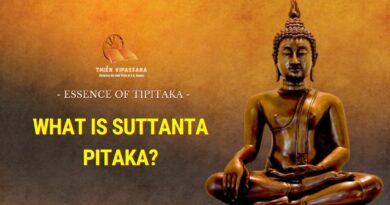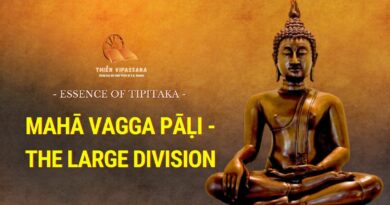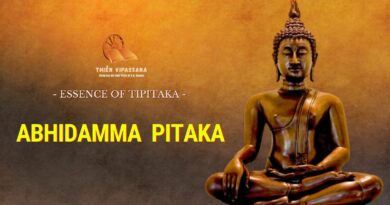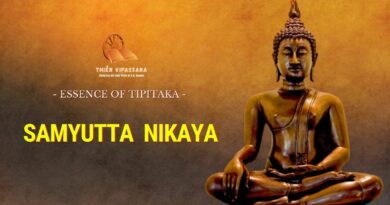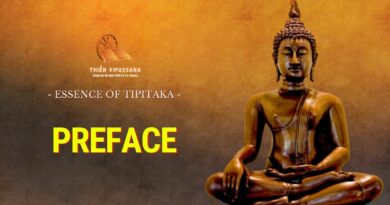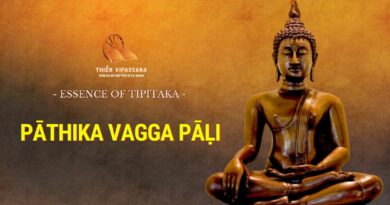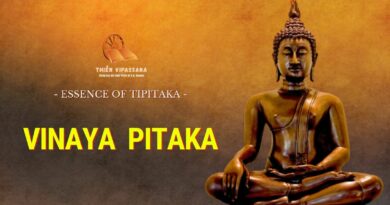4. DĪGHA NIKĀYA
This collection in the Suttanta Piṭaka is named Dīgha Nikāya as it is made up of thirty-four long discourses of the Buddha. It is divided into three divisions:
(1) Sīlakkhanda Vagga (division concerning morality)
(2) Mahā Vagga (the large division)
(3) Pāthika Vagga (the division beginning with the discourse on Pāthika, the naked ascetic)
1 Sīlakkhandha Vagga Pāḷi –
Division Concerning Morality
This division contains thirteen suttas which deal extensively with various types of morality, namely, minor morality, basic morality applicable to all; middle morality, and major morality which are mostly practised by samaṇas and brāhmaṇas. It also discusses the wrong views then prevalent as well as brahmin views of sacrifice and caste, and various religious practices such as extreme self-mortification.
Brahmajāla Sutta (Discourse on the Net of Perfect Wisdom)
An argument between Suppiya, a wandering ascetic, and his pupil Brahmadatta, with the teacher maligning the Buddha, the Dhamma and the Sangha and the pupil praising the Buddha, the Dhamma and the Sangha, gave rise to this famous discourse which is listed first in this Nikāya.
In connection with the maligning of the Buddha, the Dhamma and the Sangha, the Buddha enjoined his disciples not to feel resentment, displeasure or anger, because it would only be spiritually harmful to them. As to the words of praise for the Buddha, the Dhamma and the Sangha, the Buddha advised his disciples not to feel pleased, delighted or elated, for it would be an obstacle to their progress in the path.
The Buddha said that whatever worldling (puthujjana) praised the Buddha he could not do full justice to the peerless virtues of the Buddha, namely, his superior concentration (samādhi) and wisdom (paññā). A worldling could touch on only “matters of a trifling and inferior nature, mere morality.” The Buddha explained the three grades of morality and said that there were other dhammas profound, hard to see, subtle and intelligible only to the wise. Anyone wishing to praise correctly the true virtues of the Buddha should do so only in terms of these dhammas.
The Buddha continued to expound on various wrong views. There were samaṇas and brāhmaṇas who, speculating on the past, adhered to and asserted their wrong views in eighteen different ways, namely:
(ii) Four kinds of dualistic belief in eternity and non-eternity (ekacca sassata diṭṭhi)
(iii) Four views of the world being finite or infinite (antānanta diṭṭhi)
(iv) Four kinds of ambiguous evasion (amarāvikkhepa vāda)
(v) Two doctrines of non-causality (adhiccasamuppanna vāda)
There were samaṇas and brāhmaṇas, who, speculating on the future, adhered to and asserted their wrong views in forty-four ways, namely:
(ii) Eight kinds of belief in the non-existence of saññā after death (uddhamāghātanika asaññī vāda)
(iii) Eight kinds of belief in the existence of neither saññā nor non-saññā after death (uddhamāghātanika nevasaññī nāsaññī vāda)
(iv) Seven kinds of belief in annihilation (uccheda vāda)
(v) Five kinds of mundane nibbāna as realizable in this very life (diṭṭhadhamma nibbāna vāda)
The Buddha said that whatever samaṇas and brāhmaṇas speculated on the past or the future or both the past and the future, they did so in these sixty-two ways or one of these sixty-two ways.
The Buddha announced further that he knew all these wrong views and also what would be the destination, the next existence, in which the one holding these views would be reborn.
The Buddha gave a detailed analysis of these wrong views asserted in sixty-two ways and pointed out that these views had their origin in feeling which arose as a result of repeated contact through the six sense bases. Whatever person holds these wrong views, in him feeling gives rise to craving; craving gives rise to clinging; clinging gives rise to existence; the kammic causal process in existence gives rise to rebirth; and rebirth gives rise to ageing, death, grief, lamentation, pain, distress and despair.
But whatever person knows, as they really are, the origin of the six sense bases of contact, their cessation, their pleasurableness, their danger and the way of escape from them, he realizes the dhammas, not only mere morality (sīla) but also concentration (samādhi) and liberation (vimutti), wisdom (paññā), that transcend all these wrong views.
All the samaṇas and brāhmaṇas holding the sixty-two categories of wrong views are caught in the net of this discourse just like all the fish in a lake are contained in a finely meshed net spread by a skilful fisherman or his apprentice.
Sāmaññaphala Sutta (Discourse on the Fruits of the Life of a Samaṇa)
On one full moon night while the Buddha was residing in Rājagaha at the mango grove of Jīvaka this discourse on the fruits of the life of a samaṇa, personally experienced in this very life, was taught to King Ajātasattu on request by him. The Buddha explained to him the advantage of the life of a samaṇa by giving him the examples of a servant of his household or a landholder cultivating the King’s own land becoming a samaṇa to whom the King himself would show respect and make offerings of requisites, providing him protection and security at the same time.
The Buddha provided further elucidation on other advantages, higher and better, of being a samaṇa by elaborating on: (i) how a householder, hearing the Dhamma taught by a Buddha, leaves the home life and becomes a samaṇa out of pure faith; (ii) how he becomes established in three categories of sīla, minor, middle and major; (iii) how he gains control over his sense faculties so that no depraved states of mind such as covetousness and dissatisfaction would overpower him; (iv) how he becomes endowed with mindfulness and clear comprehension and remains contented; (v) how, by dissociating himself from five hindrances, he achieves the four jhānas (the first, the second, the third and the fourth) as higher advantages than those previously mentioned; (vi) how he becomes equipped with eight kinds of higher knowledge, namely: insight knowledge, the power of creation by mind, the psychic powers, the divine power of hearing, knowledge of the minds of others, knowledge of past existences, divine power of sight, knowledge of extinction of moral intoxicants.
Thus when the knowledge of liberation arises in him, he knows he has lived the life of purity. There is no other advantage of being a samaṇa, personally experienced, more pleasing and higher than this.
Ambaṭṭha Sutta
Ambaṭṭha, a young disciple of Pokkharasāti, the learned brahmin, was sent by his master to investigate whether Gotama was a genuine Buddha endowed with the thirty-two personal characteristics of a great man. His insolent behaviour, taking pride in his birth as a brahmin, led the Buddha to subdue him by proving that khattiya is in fact superior to brāhmaṇa. The Buddha explained further that nobleness in man stemmed not from birth but from perfection in three categories of morality, achievements of four jhānas, and accomplishments in eight kinds of higher knowledge.
Soṇadaṇḍa Sutta
This discourse was given to the brahmin Soṇadaṇḍa who approached the Buddha while he was residing near Lake Gaggarā at Campā in the country of Aṅga. He was asked by the Buddha what attributes should one possess to be acknowledged as a brahmin. Soṇadaṇḍa enumerated high birth, learning in the Vedas, good personality, morality and knowledge as essential qualities to be a brahmin. When further questioned by the Buddha, he said that the minimum qualifications were morality and knowledge without which no one would be entitled to be called a brahmin. On his request, the Buddha explained to him the meaning of the terms morality and knowledge, which he confessed to be ignorant of, namely, the three categories of morality, achievements of four jhānas and accomplishments in eight kinds of higher knowledge.
Kūṭadanta Sutta
On the eve of offering a great sacrificial feast, the brahmin Kūṭadanta went to see the Buddha for advice on how best to conduct the sacrifice. Giving the example of a former King Mahāvijita, who also made a great sacrificial offering, the Buddha declared: the principle of consent by four parties from the provinces (namely, noblemen, ministers, rich brahmins and householders); the eight qualities to be possessed by the king who would make the offerings; the four qualities of the brahmin royal adviser who would conduct the ceremonies; and the three attitudes of mind towards the sacrifices. With all these conditions fulfilled, the feast offered by the king was a great success, with no loss of life of sacrificial animals, no hardship on the people, no one impressed into service, everyone co-operating in the great feast willingly.
The brahmin Kūṭadanta then asked the Buddha if there was any sacrifice which could be made with less trouble and exertion, yet producing more fruitful result. The Buddha told him of the traditional practice of offering the four requisites to bhikkhus of high morality. Less troublesome and more profitable again was donating a monastery to the order of bhikkhus. Better still were the following practices in ascending order of beneficial effects: (i) going to the Buddha, the Dhamma, and Sangha for refuge (ii) observing the five precepts (iii) going forth from the home life and leading the holy life, becoming established in morality, becoming accomplished in the four jhānas, and becoming equipped with eight kinds of higher knowledge resulting in the realization of the extinction of āsavas. This is the sacrifice which entails less trouble and exertion but which excels all other sacrifices.
Mahāli Sutta
Mahāli Oṭṭhaddha, a Licchavi ruler, once came to see the Buddha to whom he recounted what Sunakkhatta, a Licchavi prince, had told him. Sunakkhatta had been a disciple of the Buddha for three years after which he left the teaching. He told Mahāli how he had acquired the divine power of sight by which he had seen myriads of pleasant, desirable forms belonging to the deva world but that he had not heard sounds belonging to the deva world. Mahāli wanted to know from the Buddha whether Sunakkhatta did not hear the sounds of the deva world because they were non-existent, or whether he did not hear them although they existed.
The Buddha explained that there were sounds in the deva world but Sunakkhatta did not hear them because he had developed concentration only for one purpose, to achieve the divine power of sight but not the divine power of hearing.
The Buddha explained further that his disciples practised the noble life under him not to acquire such divine powers but with a view to the realization of dhammas which far excel and transcend these mundane kinds of concentrations. Such dhammas are attainments of the four states of noble fruition-states of a stream-winner, a once-returner, a non-returner, and the state of mind and knowledge of an arahat freed of all āsavas that have been rendered extinct.
The Path by which these dhammas can be realized is the Noble Path of Eight Constituents: Right View, Right Thought, Right Speech, Right Action, Right Livelihood, Right Effort, Right Mindfulness, Right Concentration.
Jāliya Sutta
Once when the Buddha was residing at Ghositārāma Monastery near Kosambī, two wandering ascetics, Muṇḍiya and Jāliya, approached him and asked whether the soul was the physical body, or the physical body the soul, or whether the soul was one thing and the physical body another.
The Buddha explained how a person who had finally realized liberation would not even consider whether the soul was the physical body, or the physical body the soul, or whether the soul was one thing and physical body another.
Mahāsīhanāda Sutta
This discourse defines what a true samaṇa is, what a true brāhmaṇa is. The Buddha was residing in the deer park of Kaṇṇakatthala at Ujuñña. The naked ascetic Kassapa approached him and said that he had heard that Samaṇa Gotama disparaged all practices of self-mortification and that Samaṇa Gotama reviled all those who led an austere life.
The Buddha replied that they were slandering him with what was not said, what was not true. When the Buddha could see with his supernormal vision the bad destinies as well as the good destinies of those who practised extreme forms of self-mortification, and of those who practised less extreme forms of self-mortification, how could he revile all systems of self-mortification.
Kassapa then maintained that only those recluses, who for the whole of their life cultivated the practice of standing or sitting, or who were abstemious in food, eating only once in two days, seven days, fifteen days, etc., were real samaṇas and brāhmaṇas. The Buddha explained to him the futility of extreme self-mortification and said that only when a recluse practised to become accomplished in morality, concentration and knowledge, cultivated loving-kindness, dwelt in the emancipation of mind, and dwelt in the emancipation through knowledge would he be entitled to be called a samaṇa and brāhmaṇa. Then the Buddha gave a full exposition on morality, concentration and knowledge, resulting in Kassapa’s decision to join the order of the Buddha.
Poṭṭhapāda Sutta
Once when the Buddha was staying at the Monastery of Anāthapiṇḍika in the Jeta Grove at Sāvatthi he visited the Ekasālaka Hall where various views were debated. At the time Poṭṭhapāda, the wandering ascetic, asked him about the nature of the cessation of consciousness (saññā). Poṭṭhapāda wanted to know how the cessation of consciousness was brought about. The Buddha told him that it was through reason and cause that forms of consciousness in a being arose and ceased. A certain form of consciousness arose through practice (adhicitta sikkhā) and a certain form of consciousness ceased through practice.
The Buddha then proceeded to expound on these practices consisting of observance of sīla and development of concentration which resulted in arising and ceasing of successive jhānas. The meditator progressed from one stage to the next in sequence until he achieved the cessation of all forms of consciousness (nirodha samāpatti).
Subha Sutta
This is a discourse given not by the Buddha but by his close attendant, the Venerable Ānanda, on the request of young Subha. The Buddha had passed away by then. And young Subha wanted to know from the lips of the Buddha’s close attendant what dhammas were praised by the Buddha and what those dhammas were which he urged people to practise.
Ānanda told him that the Buddha had words of praise for the three aggregates of Dhamma, namely, the aggregate of morality, the aggregate of concentration and the aggregate of knowledge. The Buddha urged people to practise these dhammas, dwell in them, and have them firmly established. Ānanda explained these aggregates of Dhamma in great detail to young Subha, in consequence of which Subha became a devoted lay disciple.
Kevaṭṭa Sutta
The Buddha was residing at Nālandā in Pārāvārika’s mango grove. A devoted lay disciple approached the Buddha and urged him to let one of his disciples perform miracles so that the city of Nālandā would become devoted to the Buddha.
The Buddha told him about the three kinds of miracles which he had known and realized by himself through supernormal knowledge. The first miracle, iddhi pāṭihāriya, was rejected by the Buddha because it could be mistaken as the black art called gandhārī magic. The Buddha also rejected the second miracle, ādesanā pāṭihāriya, which might be mistaken as practice of cintāmaṇi charm. He recommended the performance of the third miracle, the anusāsanī pāṭihāriya, the miracle of the power of the teaching as it involved practice in morality, concentration and knowledge leading finally to the extinction of āsavas (āsavakkhaya ñāṇa).
Lohicca Sutta
The discourse lays down three types of blameworthy teachers: (i) the teacher who is not yet accomplished in the noble practice and teaches pupils who do not listen to him; (ii) the teacher who is not yet accomplished in the noble practice and teaches pupils who practise as instructed by him and attain emancipation; (iii) the teacher who is fully accomplished in the noble practice and teaches pupils who do not listen to him.
The praiseworthy teacher is one who has become fully accomplished in the three practices of morality, concentration and knowledge and teaches pupils who become fully accomplished like him.
Tevijja Sutta
Two brahmin youths, Vāseṭṭha and Bhāradvāja, came to see the Buddha while he was on a tour through the kingdom of Kosala. They wanted the Buddha to settle their dispute as to the correct path that led straight to companionship with Brahmā. Each one thought only the way shown by his own master was the true end.
The Buddha told them that as none of their masters had seen Brahmā, they were like a line of blind men each holding on to the preceding one. Then he showed them the true path that really led to the Brahmā realm, namely, the path of morality and concentration, and development of loving-kindness, compassion, sympathetic joy and equanimity towards all sentient beings.

